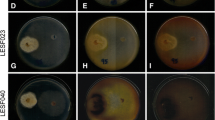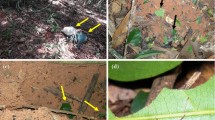Summary
Foragers of the leafcutting ant, Atta cephalotes L. (Formicidae, Attini) seldom or never attack many of the plant species available to them in nature. In the semideciduous forests of lowland Guanacaste Province, Costa Rica, one of the tree species seldom cut is Hymenaea courbaril L. (Leguminosae, Caesalpinioideae). We tested the hypothesis that this species is avoided by the ants because of the presence of ant-repellent secondary compounds in the leaves. A bioassay to test repellency of leaf extracts was developed to guide the chemical isolation of ant repellents, using a laboratory colony of Atta cephalotes.
The presence of one or more extractable ant repellents was quickly demonstrated. Subsequent chemical isolation and identification revealed that there was essentially only one terpenoid responsible for the repellency: caryophyllene epoxide. Tests with a concentration series of the pure compound demonstrated that the natural concentration of this terpenoid in Hymenaea could fully account for the observed repellency of intact leaves. Field bioassays of the terpenoid in Costa Rica confirmed this result; leaves of a preferred species, Spondias purpurea L. (Anacardiaceae), became as repellent as Hymenaea leaves when treated with caryophyllene epoxide at natural Hymenaea leaf concentrations. Repellency of the epoxide was 20 times greater than that of caryophyllene, its sesquiterpene hydrocarbon precursor, which is also found in Hymenaea leaves.
Attine ants cut leaves to serve as substrate for culturing a specific fungus for food, principally for their larvae. A reasonable hypothesis is that these ants selectively avoid plant species whose leaves contain compounds which are toxic to their fungus. We tested caryophyllene epoxide for antifungal activity and found that it is an extremely potent compound, not only against the attine fungus, but other fungi as well. We speculate that many of the other plant species avoided by these ants in nature may be similarly protected from ant attack by antifungal compounds in their leaves. We further suggest that plant defense against leafcutting ants may be largely an incidental byproduct of selection for fungal resistance in plants.
Similar content being viewed by others
References
Cherrett JM (1968) The foraging behaviour of Atta cephalotes L. (Hymenoptera, Formicidae). Foraging patterns and plant species attacked in a tropical rain forest. J Anim Ecol 37:387–403
Cherrett JM (1980) Possible reasons for the mutualism between leafcutting ants (Hymenoptera: Formicidae) and their fungus. Biol.-Ecol. mediterraneenne 7:113–122
Hubbell SP, Rockwood LL (1983) Foraging and diversity of the leaf diet in a tropical leafcutting ant. Oecologia (Berlin) (submitted)
Hubbell SP, Wiemer DF (1983) Host plant selection by an attine ant. In: Jaisson P (ed) Social Insects in the Tropics, Vol 2, Univ of Paris, Press
Janzen DH (1975) Behavior of Hymenaea courbaril when its predispersal seed predator is absent. Science 189:145–147
Khoo SF, Oehlschlager AC, Ourisson G (1973) Structure and steriochemistry of diterpenes of H. courbaril (Caesalpinioideae) seed pod resin. Tetrahedon 29:3379–3388
Langenheim JL (1967) Preliminary investigations of Hymenaea courbaril as a resin producer. J Arnold Arbor 48:203–230
Langenheim JL, Lee YT, Martin SS (1973) An evolutionary and ecological perspective of the Amazonian hylaea species of Hymenaea (Leguminosae: Caesalpinioideae). Acta Amazonica 3:5–37
Martin SS (1973) Characterization and comparison of sesquiterpenes in leaf pocket resins of Hymenaea L. (Leguminosae, Caesalpinioideae). PhD dissertation, Univ of Calif., Santa Cruz
Martin SS, Langenheim JH, Zavarin E (1972) Sesquiterpenes in leaf pocket resin of Hymenaea courbaril. Phytochemistry 11:3049–3051
Quinlan RJ, Cherrett JM (1979) The role of fungus in the diet of leafcutting ant Atta cephalotes (L.). Ecol Ent 4:151–160
Rockwood LL (1976) The effects of seasonality of foraging in two species of leaf-cutting ants (Atta). Ecology 57:48–61
Stubblebine WH, Langenheim JH (1977) Effects of Hymenaea courbaril leaf resin on the generalist herbivore Spodoptera exigua (beet armyworm). J Chem Ecol 3:633–647
Weber NA (1972) Gardening ants, the attines. Mems Amer Phil Soc 92:1–146
Author information
Authors and Affiliations
Rights and permissions
About this article
Cite this article
Hubbell, S.P., Wiemer, D.F. & Adejare, A. An antifungal terpenoid defends a neotropical tree (Hymenaea) against attack by fungus-growing ants (Atta). Oecologia 60, 321–327 (1983). https://doi.org/10.1007/BF00376846
Received:
Issue Date:
DOI: https://doi.org/10.1007/BF00376846




